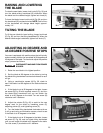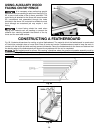
28
USING AUXILIARY WOOD
FACING ON RIP FENCE
It is necessary when performing special
operations such as moulding to add wood facing (A) Fig.
94, to one or both sides of the rip fence, as shown. The
wood facing is attached to the fence with wood screws
(B), countersunk and assembled through the holes
provided in the fence. 3/4 inch stock is suitable for most
work although an occasional job may require 1 inch
facing.
A wood facing should be used when
ripping thin material such as paneling to prevent the
material from catching between the bottom of the rip
fence and the saw table surface.
Fig. 94
B
B
A
CONSTRUCTING A FEATHERBOARD
Fig. 95, illustrates dimensions for making a typical featherboard. The material which the featherboard is constructed
of, should be a straight piece of wood that is free of knots and cracks. Featherboards are used to keep the work in
contact with the fence and table and help prevent kickbacks. Clamp the featherboards to the fence and table so that
the leading edge of the featherboards will support the workpiece until the cut is completed.
Use featherboar
ds for all non “thru-sawing” operations where the guard and spreader assembly must be
removed (see Fig. 96). Always replace the guard and spreader assembly when the non thru-sawing operation is
completed.
Fig. 95
Fig. 96


















